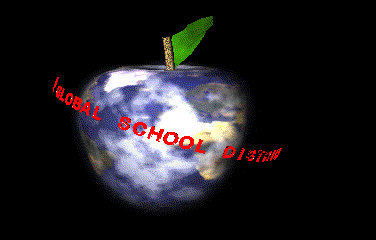

The GLOBAL SCHOOL DISTRICT is a new, FREE, service that will connect high schools across the country together through the internet. It's a complete distance learning solution ... but that's only the beginning! We have expanded the concept of distance learning to accommodate the power and flexibility of the internet. The Global School District will change the way you think of high school education forever!
In order to create a successful distance leaning system you need more than just email, web browsing and video conferencing. Schools need inexpensive teaching materials and resources that can be easily integrated into a traditional classroom setting. We have developed powerful personal networking software to bring new resources to students and teachers across the country.
Imagine a student in Iowa working with students from New York, Texas and Arizona under the guidance of a professor from Harvard. They're all trying to solve a challenging problem in which each has been given a part of the solution and specialized software to help with their analysis. Rarely does any one high school have the resources to promote teamwork and problem solving on this level. Only through our pre-existing network of science educators and institutions, cultivated for over thirty years by the Academy of Applied Sciences, can we offer such wonderful educational opportunities.
The primary goals of this system are as follows:
This easy-to-use software provides features that have never before been integrated into one package. On the surface, it provides the following functionality:
The Group Oriented Approach
Clicking on any one of the group buttons will bring up a new window. This contains all of the actions that can be performed within the group. Each group has an information page which acts as the reference point for the group's archived resources such as presentations, discussions, frequently asked questions (FAQ's) and software.
Online Classes
Chat
<joe> So on question two, why is force acting horizontally in the opposite direction of motion?
<Professor Smith> That is the force of friction, which always opposed motion.
<sam> Professor, on question eight...
All groups have this feature. Any members that are currently viewing a
group's window may participate in its chat session.
Electronic Mail and
Instantaneous Zephyr Messages
Email messages are useful for sending long or complex messages that may incorporate graphics, sound, or files from other software packages. These messages can be sent to individual users either online or offline, entire groups, or even to people on the internet that are not part of the Global School District sysem. When a new message arrives a little note appears on the specified group's button in the main toolbar. Personal mail appears within a user's own private group. Within each group window there is a button which brings up a list of email messages sent to it. Selecting a message will display it's contents.
Zephyrs are much simpler than email since they only handle text. Like email messages they can be sent to users or enitre groups. But, zephyrs immediately appear in a separate window on the designated user's screen and only function if the selected user is online. Zephyrs are preferable to email for quick, real-time messages, and also preferable to chat since it does not require viewing a specific window in order to communicate. It is possible to block receiving zephyrs from particular users or groups.
Presentations
One of the major breakthroughs in our software is the ability to incorporate customized software into the lectures. For example, a physics teacher could add a small program that illustrates the laws of motion. Students would be able to pause the lecture and experiment with the software in real-time. Users may create the programs themselves or obtain pre-made softare from the group's software library or the internet. Since this is an advanced topic there is a group devoted to helping users create such software.
Resources
Teams
Directly access
the World Wide Web
From the user's end, the Global School District is accessed through custom software developed by a team of MIT graduates. Conceptually, it's similar to AOL or Compuserve -- we provide the software through which you can access our services. The software uses your internet connection to communicate with our main system in Boston. It's like a giant conference call in that anyone connected to our system will be able to communicate with anyone else online.
The software updates itself automatically. When a new release is available it detects it and does all of the necessary installation. It has been carefully designed so that viruses cannot get into your system.
We are planning on releasing a test version of the software in September. The testing process will last one year. The production version will be unleashed on the unsuspecting public in September of 1997.
The purpose of this first release is to get the basic system tested and to let the testers help develop the content of the system. Through the feedback of our beta-testers we will be honing and redesigning the software until we're sure we have a solid, effective product.
When the first production release occurs in September of '97 the system will be able to offer high school and university courses online, as well as contain many powerful tools for teaching classes both inside and outside of the system.
To join the Global School District simply download and install the software onto your machine. That's it! We've designed it to be as easy as possible -- all of the updates to the software are automatic!
Hopefully this has given you a decent idea of what the Global School District is all about. Check back here for progress reports, updates, and demo software.
Wes Sonnenreich -- sonny@mit.edu
Academy Of Applied Science
Global School District Project